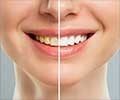Novel treatment with a new type of cerium nanoparticle formulation could someday stop plaque and cavities from forming in the first place, reports a new study.

‘Streptococcus mutans has long been a target of interest for antimicrobial therapy in the field of oral medicine. S. mutans produces robust tooth-borne biofilms that serve a key etiological factor in the progression of dental caries and odontogenic infections.
’





Silver-based bactericidal agents can effectively decrease oral Streptococcus mutans proliferation, yet their repeated administration has raised concerns of emerging bacterial resistance and harmful effects on oral microbiota. Tooth-applied biofilm inhibitors with non-lethal mechanisms of action have offered a novel way for both limiting biofilm formation and diminishing effects on the entirety of the oral microbiome. The use of nanoparticles in this capacity has gained considerable interest in recent years. The researchers will present their progress toward this goal today at the American Chemical Society (ACS) Fall 2020 Virtual Meeting & Expo. ACS is holding the meeting through Thursday. It features more than 6,000 presentations on a wide range of science topics.
The mouth contains more than 700 species of bacteria, says Russell Pesavento, D.D.S., Ph.D., the project's principal investigator. They include beneficial bacteria that help digest food or keep other microbes in check. They also include harmful streptococcal species, including Streptococcus mutans. Soon after cleaning, these bacteria stick to teeth and begin multiplying. With sugar as an energy source and building block, the microbes gradually form a tough film that can't easily be removed by brushing. As the bacteria continue metabolizing sugar, they make acid byproducts that dissolve tooth enamel, paving the way for cavities.
Dentists and consumers can fight back with products, including stannous fluoride, to inhibit plaque and silver nitrate or silver diamine fluoride from stopping existing tooth decay. Researchers have also studied nanoparticles made of zinc oxide, copper oxide, or silver to treat dental infections. Although bactericidal agents such as these have their place in dentistry, repeated applications could lead to both stained teeth and bacterial resistance, according to Pesavento, who is at the University of Illinois at Chicago. "Also, these agents are not selective, so they kill many types of bacteria in your mouth, even good ones," he explains.
So, Pesavento wanted to find an alternative that wouldn't indiscriminately kill bacteria in the mouth, and that would help prevent tooth decay, rather than treat cavities after the fact. He and his research group turned to cerium oxide nanoparticles. Other teams had examined the effects of various types of cerium oxide nanoparticles on microbes, though only a few had looked at their effects on clinically relevant bacteria under initial biofilm formation conditions. Those that did so prepared their nanoparticles via oxidation-reduction reactions or pH-driven precipitation reactions, or bought nanoparticles from commercial sources. Those prior formulations either had no effect or even promoted biofilm growth in lab tests, he says.
Advertisement
"The advantage of our treatment is that it looks to be less harmful to oral bacteria, in many cases not killing them," Pesavento says. Instead, the nanoparticles merely prevented microbes from sticking to polystyrene surfaces and forming adherent biofilms. In addition, the nanoparticles' toxicity and metabolic effects in human oral cells in petri dishes were less than those of silver nitrate.
Advertisement
Source-Eurekalert















